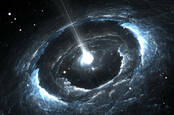This article is more than 1 year old
Scientists shed light on oddball gamma rays from deep space
They thought they'd grokked short and long types.... then an awkward third kind came along
Once the data looked straightforward, at least in terms of bursts of gamma rays from outer space. The high-energy electromagnetic radiation was classified into two types: short bursts of less than a second, thought to come from two merging neutron stars in a binary system; and long bursts of a few seconds or more from the collapse of a massive star.
Or so the thinking went. But in 2006, NASA's Neil Gehrels Swift observatory found a new kind of long gamma-ray burst with no evidence of a collapsing star. The finding kicked off a puzzle that four papers in Nature this week claim to go some way to solving.

Years after we detected two neutron stars crashing into each other, we're still picking up X-rays. We don't know why
READ MOREIn an accompanying article, Luigi Piro, professor at Italy's National Astrophysics Institute, explained: "Over the past 25 years, astronomers have studied emissions at wavelengths longer than gamma-rays to pinpoint the source of these bursts, and have deduced that the two classes of burst come from distinct progenitor systems. Long γ-ray bursts take place in galaxies with irregular or spiral-shaped geometries, occurring preferentially in bright star-forming regions in the central part of the galaxy.
"The spectra of these bursts contain features consistent with supernovae, which are considered indisputable proof of the connection between long γ-ray bursts and the collapse of massive stars. By contrast, short γ-ray bursts can come from both spiral-shaped galaxies and more-regular elliptical galaxies, but always originate in isolated regions that are often far from the centres of their host galaxies."
- Bright light from black holes found to be caused by particle shock waves
- How did ESA's gamma ray-spotting 'scope make it to 20? They totally overdid it
- It's safe to leave your bunker: Blame that Chinese nuclear plant alarm on fuel rod faults
- A high-energy neutrino, a powerful cosmic ray, and a gamma ray walk into a bar... Where you from, asks the bartender
Then came along evidence of long-gamma ray bursts with no evidence of collapsing stars or supernovas. With the help of the information from gravitational wave detectors, astrophysicists have been able to present "indisputable evidence" that these anomalous long bursts of gamma rays are also connected to mergers of compact objects such as neutron stars, overturning years of established thinking in astrophysics.
Alessio Mei, PhD student at Gran Sasso Science Institute in L'Aquila, Italy, also showed that the third class of gamma ray bursts also emit more high-energy photons than expected in the gigaelectronvolt range, whereas previously, the only known electromagnetic signature of a kilonova was the optical infrared flash.
Piro said the next decade is set to uncover a treasure trove of evidence in the field as the next generation of Earth-based gravitational wave laboratories Laser Interferometer Gravitational-Wave Observatory (LIGO), such as the Virgo interferometer, near Pisa, Italy, and the Kamioka Gravitational Wave Detector (KAGRA) in Japan is planned for 2023 and 2026 repectively. They could uncover hundreds of neutron-star mergers, about 1 in 10 of which could be associated with "the strange hybrid γ-ray bursts reported in the four papers." ®
